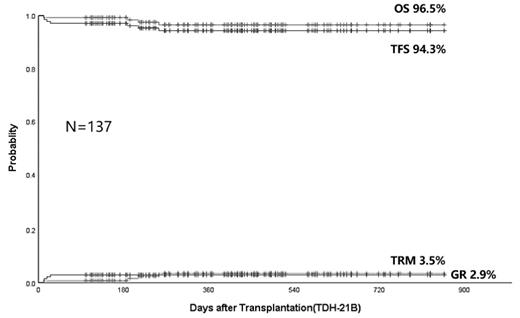Background: Hematopoietic stem cell transplantation (HSCT) remains a proven curative approach for patients with thalassemia major (TM) over long-term practice. However, achieving successful engraftment and managing graft-versus-host disease (GVHD) continue to pose significant challenges. While low incidence of GVHD has been observed in Tαβ + cell-depleted HSCT (TDH) from haploidentical donors, graft failure (GF) remains a considerable concern, particularly in patients with TM. To enhance the engraftment in TM-TDH, we conducted this prospective/retrospective single-center clinical study.
Method: A total of 137 patients diagnosed with TM received TDH at the BMT-center, Taixin Hospital, between March 2021 and April 2023. The median age of the patients was 7 years (ranging from 2 to 19 years), with 89 males and 48 females. The median follow-up time was 408 days (ranging from 99 to 857 days). The conditioning regimen consisted of Thymoglobulin on -day 21, followed by 3-Gy total body irradiation on -day 11. On -day 10, the patients received an infusion of donor lymphocytes (2*10 8/kg), followed by cyclophosphamide (Cy) at a dose of 50mg/kg on days -8, -7, and -2, and 25mg/kg on day -1. Additionally, blood-concentration adjusted busulfan was administered on days -6 to -4, fludarabine at a dose of 40mg/kg on days -6 to -2, and thiotepa at 10mg/kg on day -3. For GVHD prophylaxis, short-term (< 6 months) low-dose tacrolimus or sirolimus with or without mycophenolate mofetil was used. The mean infused CD34+ cells were 31.09 (ranging from 14.25 to 61.12) *10 6/kg, TCRγδ+ cells were 39.49 (ranging from 5.18 to 140.39) *10 6/kg, and NK cells were 109.18 (ranging from 27.52 to 309.41) *10 6/kg, respectively. The targeted infusion of TCRαβ+ cells was aimed at 1.5-2.0*10 5/kg.
Results: Out of the 137 patients, 133 achieved successful engraftment (97.1%) with median engraftment times of 16 days (ranging from 9 to 48 days) for ANC to reach 0.5x10 9/L, 11 days (ranging from 1 to 23 days) for HB to reach 80g/L, and 10 days (ranging from 5 to 22 days) for platelets to reach 20x10 9/L, respectively. GF was observed in four patients. Among them, two patients with GF underwent salvage alternative donor second HSCT on +day 19 and +day 32, respectively, and are currently thalassemia-free. One patient received infusion of cryopreserved auto-peripheral blood stem cell and continues to live with TM. Unfortunately, four patients passed away, with one GF patient dying from suspected virus myocarditis on +day 11, one potentially due to virus hepatitis or hepatic GVHD on day +188, and the remaining two from virus bronchiolitis obliterans on +day 211 and +day 254, respectively. The overall survival (OS) and thalassemia-free survival (TFS) rates were 96.5% and 94.3%, respectively. The incidence of GF and transplant-related mortality (TRM) were 2.9% and 3.5%, respectively (Fig.). Acute GVHD of grade I-II and grade III-IV was observed in 10.53% and 9.02% of patients, respectively, while mild and moderate chronic GVHD occurred in 7(5.1%) and 1(0.7%) patient(s), respectively. The incidence of veno-occlusive disease was mild and limited.
C onc lusion: The current study demonstrates the efficacy of a novel protocol in enhancing engraftment in TDH for patients with TM and with low incidence of both acute GvHD and chronic GvHD. This approach represents a significant advancement in the field of TM-TDH.
Fig.1 Curve of OS, TFS, TRM and Rejection in TM-TDH
Disclosures
No relevant conflicts of interest to declare.


This feature is available to Subscribers Only
Sign In or Create an Account Close Modal